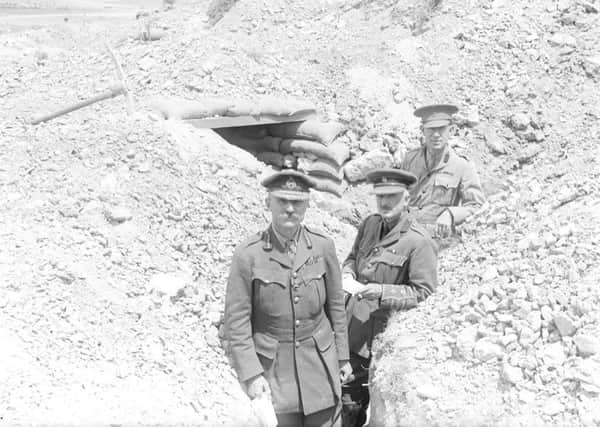Revealed: scapegoat Scots general attacked Haig's Somme strategy


Such a man was Sir Aylmer Hunter-Weston – Scotland’s most unpopular First World War general – whose family estate was in Hunterston, West Kilbride, and who was nicknamed “Hunter Bunter”. He was the lieutenant general whose forces were routed at the northern end of the British line in the great attack that started the Battle of the Somme. That performance ensured that he was generally regarded as one of the archetypical ignorant, bloodthirsty buffoons; a donkey who should never have been put in charge of our long suffering troops.
His sentences were full of flamboyant exclamations such as “How jolly!”, “Capital!”, and, when talking about a shell, “What a nice little chap!”
Advertisement
Hide AdAdvertisement
Hide AdThe approach of Remembrance Sunday next week is as good a time as any to reappraise our judgments on the war. And whatever blame sticks to Hunter-Weston as a result of the disastrous failure of his VIIIth Corps on the Somme during the infamous 1 July, 1916, attack, when his 50,000-strong formation sustained around 15,000 casualties – a substantial contribution to the 57,000 British casualties that day – there is a sneaking suspicion his reputation was sacrificed to save those higher up.
The problem subordinate generals such as Hunter-Weston were facing during the lead-up to the Somme attack emanated from their commander-in-chief as much as from the Germans. General Douglas Haig, Hunter-Weston’s Scottish leader, was all for ordering his troops to rush towards the Germans’ front two lines, assuming that the enemy would have long since been stunned, if not wiped out, by British artillery.
Hidden away in Hunter-Weston’s papers in the vaults of the British Library, documents reveal that three months before the battle started, Hunter-Weston ripped into Haig’s plan, describing it as “foolish generalship”.
According to Hunter-Weston, by the time the remnants of the three attacking divisions had arrived at the German front line, they would be “lucky to have a brigade in hand” to attack the second line. And in the unlikely event these brave souls reached the second German line, they would almost certainly be a “widely spread disorganised rabble with no power to overcome even a feeble resistance in the enemy back trenches”.
Hunter-Weston had similarly criticised the initial attack at Gallipoli the previous year, and given that he had been proved correct, it is most unfortunate that he was persuaded by Haig and General Henry Rawlinson, the top commander on the Somme, to drop his objections to an attack plan once again.
This is not to say that Hunter-Weston did not make critical errors while executing the plan which he eventually accepted. He infamously allowed a huge mine to be blown up under the German line ten minutes before the attack started, thereby warning the Germans the attack was about to begin.
He ordered some of the artillery to stop firing at the German front line when the attack was about to start, the very moment when concentrated fire was vital.
And he enabled the Germans to gauge exactly where his troops would attack by not telling his northern division to pretend they were about to advance.
Advertisement
Hide AdAdvertisement
Hide AdBut for all his faults, he was the first general who, after the attack had failed with those enormous casualties, reported to Haig’s superior officer, General Sir William Robertson, the Chief of the Imperial General Staff, that he would have needed more than six times as many shells as he had been given to do the job properly.
“The latter is for your ear alone,” he said, adding: “It is inadvisable to give currency to such unpleasant and dangerous facts.”
His perspicacious advice was duly hushed up, and ironically he, one of the few generals who had noticed that Haig’s plan was impossible, was sent away from the Somme to a quieter sector, never to return again.
The paperback edition of Hugh Sebag-Montefiore’s Somme: Into The Breach published by Penguin is out now, as is the updated paperback 75th Anniversary edition of his Enigma: the Battle for the Code with new material added, published by Orion’s Weidenfeld & Nicolson